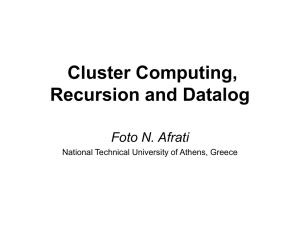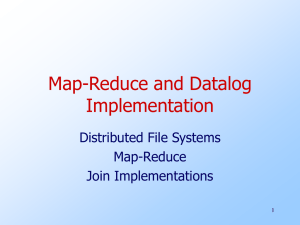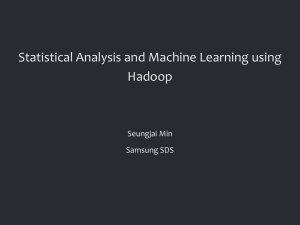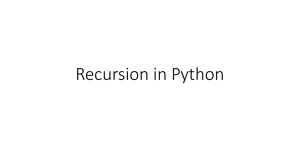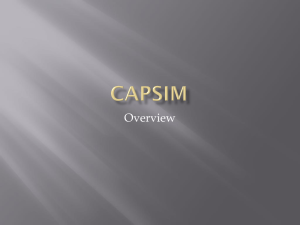Map - The Stanford University InfoLab
advertisement
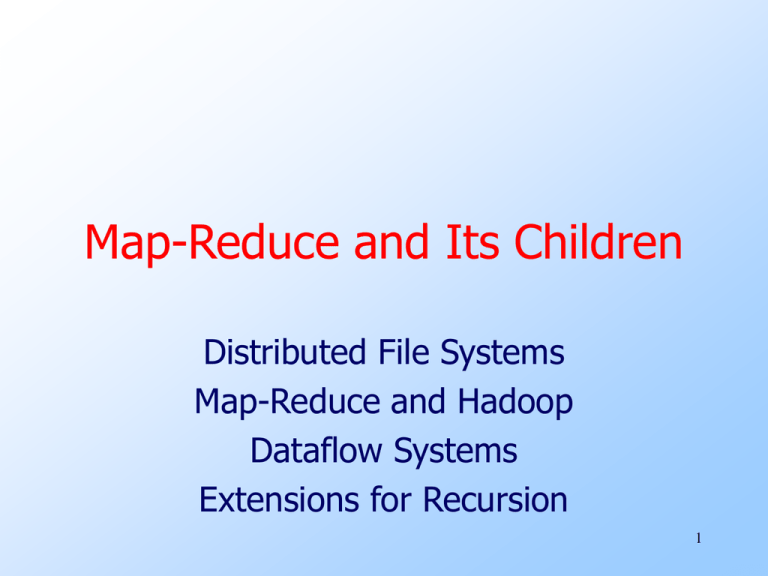
Map-Reduce and Its Children Distributed File Systems Map-Reduce and Hadoop Dataflow Systems Extensions for Recursion 1 Distributed File Systems Chunking Replication Distribution on Racks 2 Distributed File Systems Files are very large, read/append. They are divided into chunks. Typically 64MB to a chunk. Chunks are replicated at several compute-nodes. A master (possibly replicated) keeps track of all locations of all chunks. 3 Compute Nodes Organized into racks. Intra-rack connection typically gigabit speed. Inter-rack connection faster by a small factor. 4 Racks of Compute Nodes File Chunks 5 3-way replication of files, with copies on different racks. 6 Implementations GFS (Google File System – proprietary). HDFS (Hadoop Distributed File System – open source). CloudStore (Kosmix File System, open source). 7 Above the DFS Map-Reduce Key-Value Stores SQL Implementations 8 The New Stack SQL Implementations, e.g., PIG (relational Object Store (key-value algebra), HIVE store), e.g., BigTable, Hbase, Cassandra Map-Reduce, e.g. Hadoop Distributed File System 9 Map-Reduce Systems Map-reduce (Google) and open-source (Apache) equivalent Hadoop. Important specialized parallel computing tool. Cope with compute-node failures. Avoid restart of the entire job. 10 Key-Value Stores BigTable (Google), Hbase, Cassandra (Apache), Dynamo (Amazon). Each row is a key plus values over a flexible set of columns. Each column component can be a set of values. 11 SQL-Like Systems PIG – Yahoo! implementation of relational algebra. Translates to a sequence of map-reduce operations, using Hadoop. Hive – open-source (Apache) implementation of a restricted SQL, called QL, over Hadoop. 12 SQL-Like Systems – (2) Sawzall – Google implementation of parallel select + aggregation. Scope – Microsoft implementation of restricted SQL. 13 Map-Reduce Formal Definition Fault-Tolerance Example: Join 14 Map-Reduce You write two functions, Map and Reduce. They each have a special form to be explained. System (e.g., Hadoop) creates a large number of tasks for each function. Work is divided among tasks in a precise way. 15 Map-Reduce Pattern “key”-value pairs Input from DFS Output to DFS Map tasks Reduce tasks 16 Map-Reduce Algorithms Map tasks convert inputs to key-value pairs. “keys” are not necessarily unique. Outputs of Map tasks are sorted by key, and each key is assigned to one Reduce task. Reduce tasks combine values associated with a key. 17 Coping With Failures Map-reduce is designed to deal with compute-nodes failing to execute a task. Re-executes failed tasks, not whole jobs. Failure modes: 1. Compute node failure (e.g., disk crash). 2. Rack communication failure. 3. Software failures, e.g., a task requires Java n; node has Java n-1. 18 Things Map-Reduce is Good At 1. Matrix-Matrix and Matrix-vector multiplication. One step of the PageRank iteration was the original application. 2. Relational algebra operations. We’ll do an example of the join. 3. Many other “embarrassingly parallel” operations. 19 Joining by Map-Reduce Suppose we want to compute R(A,B) JOIN S(B,C), using k Reduce tasks. I.e., find tuples with matching B-values. R and S are each stored in a chunked file. 20 Joining by Map-Reduce – (2) Use a hash function h from B-values to k buckets. Bucket = Reduce task. The Map tasks take chunks from R and S, and send: Tuple R(a,b) to Reduce task h(b). • Key = b value = R(a,b). Tuple S(b,c) to Reduce task h(b). • Key = b; value = S(b,c). 21 Joining by Map-Reduce – (3) Map tasks send R(a,b) if h(b) = i Reduce task i Map tasks send S(b,c) if h(b) = i All (a,b,c) such that h(b) = i, and (a,b) is in R, and (b,c) is in S. 22 Joining by Map-Reduce – (4) Key point: If R(a,b) joins with S(b,c), then both tuples are sent to Reduce task h(b). Thus, their join (a,b,c) will be produced there and shipped to the output file. 23 Dataflow Systems Arbitrary Acyclic Flow Among Tasks Preserving Fault Tolerance The Blocking Property 24 Generalization of Map-Reduce Map-reduce uses only two functions (Map and Reduce). Each is implemented by a rank of tasks. Data flows from Map tasks to Reduce tasks only. 25 Generalization – (2) Natural generalization is to allow any number of functions, connected in an acyclic network. Each function implemented by tasks that feed tasks of successor function(s). Key fault-tolerance (blocking ) property: tasks produce all their output at the end. 26 Many Implementations 1. 2. 3. 4. 5. 6. Clustera – University of Wisconsin. Hyracks – Univ. of California/Irvine. Dryad/DryadLINQ – Microsoft. Nephele/PACT – T. U. Berlin. BOOM – Berkeley. epiC – N. U. Singapore. 27 Example: Join + Aggregation Relations D(emp, dept) and S(emp,sal). Compute the sum of the salaries for each department. D JOIN S computed by map-reduce. But each Reduce task can also group its emp-dept-sal tuples by dept and sum the salaries. 28 Example: Continued A Third function is needed to take the dept-SUM(sal) pairs from each Reduce task, organize them by dept, and compute the final sum for each department. 29 3-Layer Dataflow D S Final Group + Aggregate Join + Group Tasks Map Tasks Hash by emp Hash by dept 30 Recursion Transitive-Closure Example Fault-Tolerance Problem Endgame Problem Some Systems and Approaches Recent research ideas contributed by F. Afrati, V. Borkar, M. Carey, N. Polyzotis 31 Applications Requiring Recursion 1. PageRank, the original map-reduce application is really a recursion implemented by many rounds of mapreduce. 2. Analysis of Web structure. 3. Analysis of social networks. 4. PDE’s. 32 Transitive Closure Many recursive applications involving large data are similar to transitive closure : Path(X,Y) :- Arc(X,Y) Path(X,Y) :- Path(X,Z) & Path(Z,Y) Nonlinear Path(X,Y) :- Arc(X,Y) Path(X,Y) :- Arc(X,Z) & Path(Z,Y) (Right) Linear 33 Implementing TC on a Cluster Use k tasks. Hash function h sends each node of the graph to one of the k tasks. Task i receives and stores Path(a,b) if either h(a) = i or h(b) = i, or both. Task i must join Path(a,c) with Path(c,b) if h(c) = i. 34 TC on a Cluster – Basis Data is stored as relation Arc(a,b). Map tasks read chunks of the Arc relation and send each tuple Arc(a,b) to recursive tasks h(a) and h(b). Treated as if it were tuple Path(a,b). If h(a) = h(b), only one task receives. 35 TC on a Cluster – Recursive Tasks Path(a,b) received Store Path(a,b) if new. Otherwise, ignore. Task i Send Path(a,c) to tasks h(a) and h(c); send Path(d,b) to tasks h(d) and h(b) Look up Path(b,c) and/or Path(d,a) for any c and d 36 Big Problem: Managing Failure Map-reduce depends on the blocking property. Only then can you restart a failed task without restarting the whole job. But any recursive task has to deliver some output and later get more input. 37 HaLoop (U. Washington) Iterates Hadoop, once for each round of the recursion. Like iterative PageRank. Similar idea: Twister (U. Indiana). Clever piece is the way HaLoop tries to run each task in round i at a compute node where it can find its needed output from round i – 1. 38 Pregel (Google) Views all computation as a recursion on some graph. Nodes send messages to one another. Messages bunched into supersteps. Checkpoint all compute nodes after some fixed number of supersteps. On failure, rolls all tasks back to previous checkpoint. 39 Example: Shortest Paths Via Pregel I found a path from node M to you of length L I found a path from node M to you of length L+5 I found a path from node M to you of length L+3 Is this the shortest path from M I know about? Node N 5 3 I found a path from node M to you of length L+6 table of shortest paths to N 6 40 Using Idempotence Some recursive applications allow restart of tasks even if they have produced some output. Example: TC is idempotent; you can send a task a duplicate Path fact without altering the result. But if you were counting paths, the answer would be wrong. 41 Big Problem: The Endgame Some recursions, like TC, take a large number of rounds, but the number of new discoveries in later rounds drops. T. Vassilakis (Google): searches forward on the Web graph can take hundreds of rounds. Problem: in a cluster, transmitting small files carries much overhead. 42 Approach: Merge Tasks Decide when to migrate tasks to fewer compute nodes. Data for several tasks at the same node are combined into a single file and distributed at the receiving end. Downside: old tasks have a lot of state to move. Example: “paths seen so far.” 43 Approach: Modify Algorithms Nonlinear recursions can terminate in many fewer steps than equivalent linear recursions. Example: TC. O(n) rounds on n-node graph for linear. O(log n) rounds for nonlinear. 44 Advantage of Linear TC The data-volume cost (= sum of input sizes of all tasks) for executing linear TC is generally lower than that for nonlinear TC. Why? Each path is discovered only once. Note: distinct paths between the same endpoints may each be discovered. 45 Example: Linear TC Arc + Path = Path 46 Nonlinear TC Constructs Path + Path = Path in Many Ways 47 Smart TC (Valduriez-Boral, Ioannides) Construct a path from two paths: 1. The first has a length that is a power of 2. 2. The second is no longer than the first. 48 Example: Smart TC 49 Other Nonlinear TC Algorithms You can have the unique-decomposition property with many variants of nonlinear TC. Example: Balance constructs paths from two equal-length paths. Favor first path when length is odd. 50 Example: Balance 51 Incomparability of TC Algorithms On different graphs, any of the uniquedecomposition algorithms – left-linear, right-linear, smart, balanced – could have the lowest data-volume cost. Other unique-decomposition algorithms are possible and also could win. 52 Extension Beyond TC Can you convert any linear recursion into an equivalent nonlinear recursion that requires logarithmic rounds? Answer: Not always, without increasing arity and data size. 53 Positive Points 1. (Agarwal, Jagadish, Ness) All linear Datalog recursions reduce to TC. 2. Right-linear chain-rule Datalog programs can be replaced by nonlinear recursions with the same arity, logarithmic rounds, and the unique-decomposition property. 54 Example: Alternating-Color Paths P(X,Y) :- Blue(X,Y) P(X,Y) :- Blue(X,Z) & Q(Z,Y) Q(X,Y) :- Red(X,Z) & P(Z,Y) 55 The Case of Reachability Reach(X) :- Source(X) Reach(X) :- Reach(Y) & Arc(Y,X) Takes linear rounds as stated. Can compute nonlinear TC to get Reach in O(log n) rounds. But, then you compute O(n2) facts instead of O(n) facts on an n-node graph. 56 Reachability – (2) Theorem: If you compute Reach using only unary recursive predicates, then it must take (n) rounds on a graph of n nodes. Proof uses the ideas of Afrati, Cosmodakis, and Yannakakis from a generation ago. 57 Summary: Recursion Key problems are “endgame” and nonblocking nature of recursive tasks. In some applications, endgame problem can be handled by using a nonlinear recursion that requires O(log n) rounds and has the unique-decomposition property. 58 Summary: Research Questions 1. How do you best support fault tolerance when tasks are nonblocking? 2. How do you manage tasks when the endgame problem cannot be avoided? 3. When can you replace linear recursion with nonlinear recursion requiring many fewer rounds and (roughly) the same data-volume cost? 59
